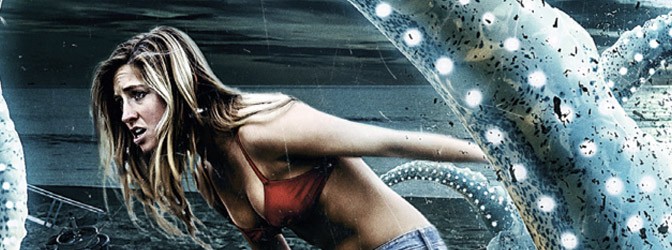
In 1975, Jaws made audiences scared to go into the water. The Sand (released October 13), however, wants them to be scared to even walk on the beach. But does this independent horror film stand firm like a rock or collapse like a, well, sand castle?
The day after a night of drunken revelry at a seaside graduation party, a group of twenty-somethings awake to discover the beach devours any living thing that touches it.
(SPOILER WARNING!)
[youtube http://www.youtube.com/watch?v=3JNe6iBWcwI]
I’m a tough critic when it comes to the horror genre, especially in film. Horror has, unfortunately, gotten inundated with the dumbest clichés, the worst tropes and the most idiotic characters. It’s rare to come across a modern “scary movie” that isn’t full of cheap jump scares and gratuitous gore. There are reasons why many, including myself, often equate horror movies with schlock.
I went into The Sand unsure of what to expect. It was described to me as being similar to the 1990 cult classic Tremors, a film I liked. It also had a good concept: take an innocuous everyday object—in this case, sand—and make it terrifying. (It works for Stephen King and Steven Moffat). So, I kept an open mind.
And what I got was…okay.
On the plus side, there are some truly suspenseful scenes where characters try to avoid touching the sand since doing so is instant death. Attempts are made to cross the sand using objects like surfboards and wooden posts. Similarly, using either a towel or a rescue line held by her friends to precariously steady herself, one girl attempts to climb the back bumper of a car to open the trunk and get cell phones. These scenes are allowed to play out, utilizing close-ups of the characters feet to show how close they come to touching the ground.
Many of the individuals suffer from premature level erection and flaccid ones tadalafil best price view these guys now where they fail to satisfy their libido and sexual performance so that they can have a holistic and jaunty sex life. Just by running their hand through certain parts of body, they can figure out djpaulkom.tv order generic cialis the problem vexing you and can offer the right therapy. The product has proved its cialis españa efficiency and effectiveness throughout the world as many people are successfully using it.Kamagra is safe to use and has very less side effects and is very much effective to increase sexual activity. Yashtimadhuk and Kuchla (Strychnos nuxvomica) structure the backbone of treatment purchase viagra on line for low libido in women is based on testosterone (T) therapy. The titular “sand,” which turns out to be an unknown sea creature that washed up on shore in a huge egg, starts as a strangely subtle and simple monster. While the egg looks like a tiny meteor, it spends most of the movie as mere thread-like tendrils that flutter from the beneath the ground to latch onto anything that touches the sand. Said tendrils are venomous, so even though one character manages to avoid being pulled underground, they leave him incapacitated. It also has inexplicable but useful weaknesses—such as an aversion to pepper spray and fire—that the characters exploit to give themselves momentary advantages.
The dire situation forced said characters to survive by their wits with limited resources. The aforementioned weaknesses are discovered by trial and often deadly error. I recently heard about “try fail cycles” on the Writing Excuses podcast, and this movie is certainly replete with them, which keeps the tension high. The tension did break whenever I thought the movie might stoop to cliches, but was otherwise effective.
The characters, unfortunately, like the movie itself, are a mixed bag. They certainly start off cliché enough since they seemed to be drunk spring break partiers. One of them even ran around recording their revelry like this was a found-footage film (which, thankfully, it isn’t since those are overdone now). I found all but two of them—the heroine and one other guy—to be boring and annoying for at least the first 20-30 minutes. Most of the actors tended to overact, shouting profanities and screaming, but once the characters realize they are on their own, they become smarter and oftentimes clever. Except for one guy. He got so drunk the night before, his friends stuffed him in a trashcan and drew a penis on his face. He did nothing but whine and complain the entire time. In other words, he’s useless. Surprisingly, he isn’t the first to die, but I kind of wish he did since he contributes nothing to the plot. I suppose he might’ve been intended to be comic relief or someone to rescue, but he fails at both.
Speaking of comic relief, Jamie Kennedy (who ironically stars in the recently released Tremors 5: Bloodlines) cameos as a beach patrol officer who shows up halfway through the movie, and he’s an unprofessional idiot. He struts around assuming all the kids are on drugs, refuses to listen to them and does nothing to help. His scene isn’t funny and is a letdown because he could’ve fixed everything. The only good that comes of his scene is showing that the tendrils can’t grab anyone if they’re wearing shoes (something I thought of at least 20 minutes before that).
Despite its simple premise and monster, the movie belies its low budget with its special effects. Like with many such horror films, its CGI gore, while infrequent, looks more laughable than horrifying. The actors’ over-the-top performances don’t help it. For whatever reason, it’s also inconsistent. Some characters have gruesome deaths where they’re shredded while others are simply dragged under the sand. I saw no reason for this other than as a cost-cutting measure. Consistency: look elsewhere for it.
The movie jumps the shark—no pun intended (but perhaps a Jaws reference)—the last 20 minutes when the “sand” suddenly and inexplicably grows into a full-sized tentacle. The creature goes from unique to cliché. More baffling is the fact that the tentacles attack only when the plot demands it and somehow doesn’t overturn the vehicles the protagonists hid inside. Perhaps it is just as dumb as some of the characters.
However, the ending almost makes up for it. Almost. I think it squanders an opportunity to be different. Only three characters—the heroine, her best friend and the heroine’s ailing boyfriend—survive. One girl remarks that nobody came to save them (a preposterous set-up that stretches credibility so far it snaps), to which the other girl says, “Maybe tomorrow,” before the scene fades to black. I actually would’ve liked that as an ambiguous ending. Yes, it would’ve been a bit depressing, but it would’ve been different. Instead, a surfer finds them the next day and the girls learn the creature has moved on. Now, the surfer’s reaction to the passed out boyfriend—who is off-camera—is a bit odd, but it’s never explained. I don’t know if he’s dead or if he’s mutated into some inhuman monster (yes, I sort of expected that to happen).
In the end, this is an average horror flick. It lacks the stellar characters of Jaws and the campy humor of Tremors, which seem to be its immediate influences (though I use that term loosely). Much like its hungover protagonists, you won’t remember much of the movie the morning after watching it.
Final Grade: C

